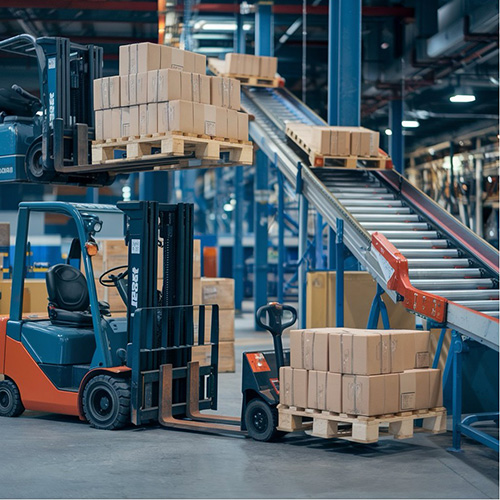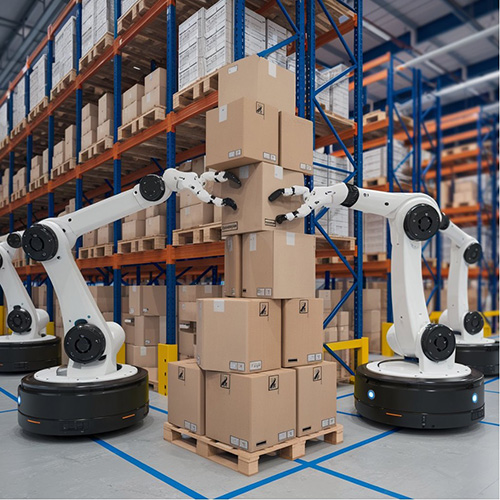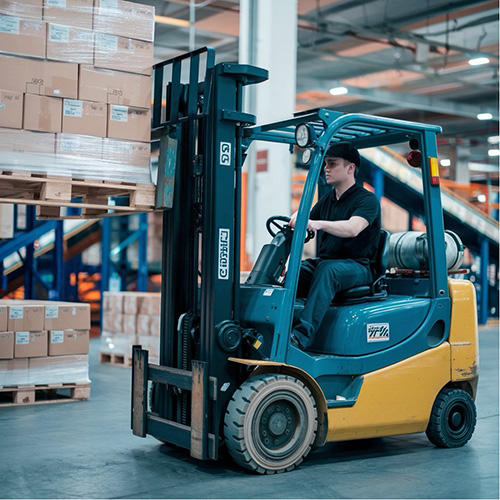An analysis of the demand for automated solutions in sectors such as manufacturing and logistics because of advances in robotics, AI and IoT.

By: Sheetal Borkar of Markets and Markets
The Automated Material Handling Equipment (AMHE) market in North America is experiencing rapid growth as industries increasingly adopt automation technologies to streamline operations, improve efficiency, and reduce costs. With advances in robotics, AI, and IoT, the demand for automated solutions in sectors such as e-commerce, manufacturing, and logistics has surged.
Key players like Honeywell, Daifuku North America, and KION Group are leading the charge, introducing advanced AMHE systems such as automated guided vehicles (AGVs), conveyor systems, robotic picking systems, and automated storage and retrieval systems (AS/RS).
The AMHE market in North America is expected to grow at a CAGR of over 7% through 2028. The adoption of autonomous mobile robots (AMRs) and collaborative robots is accelerating, with companies investing in solutions that enhance both flexibility and efficiency.
The global Automated Material Handling Equipment market size is foreseen to grow from USD 33.3 billion in 2024 to USD 51.0 billion by 2029, at a CAGR of 8.9% from 2024 to 2029.
In the manufacturing sector, industries like automotive, electronics, and food and beverage are increasingly automating material handling processes to meet demand while reducing operational costs. Government incentives supporting smart manufacturing initiatives, such as the Manufacturing USA program, are also contributing to this trend.
As companies continue to modernize their supply chains, the future of AMHE in North America looks promising, with cutting-edge automation technology transforming the way businesses handle materials, manage warehouses, and meet consumer demands.
Automated Material Handling Equipment (AMHE) is increasingly transforming supply chains, warehouses, and manufacturing facilities across North America. With the rising demand for efficiency, speed, and precision in industries such as e-commerce, manufacturing, automotive, and retail, the AMHE market has seen significant growth over the past few years.
To meet these demands, companies are investing heavily in automated guided vehicles (AGVs), autonomous mobile robots (AMRs), automated storage and retrieval systems (AS/RS), and conveyor systems that streamline logistics and material handling processes. These technologies enable businesses to handle high-volume orders, reduce human errors, and minimize operational costs.

Another major factor driving AMHE adoption is the ongoing labor shortage in North America. The warehousing and logistics sectors have struggled to find sufficient workers, leading companies to embrace automation. AMHE helps businesses cope with these challenges by automating repetitive tasks like picking, packing, and transporting materials, allowing facilities to operate with fewer human resources while maintaining productivity.
Additionally, rising labor costs in North America make automation a more attractive option for businesses seeking to optimize their operations. By replacing labor-intensive processes with automated solutions, companies can reduce dependency on manual labor and increase profitability.
The adoption of Industry 4.0 technologies and the rise of smart warehousing are transforming how businesses manage their supply chains. By integrating AMHE with IoT (Internet of Things), AI (Artificial Intelligence), and data analytics, companies can create interconnected, self-optimizing systems that enhance operational visibility and decision-making.
Smart warehouses equipped with autonomous robots and automated control systems can perform real-time inventory management, predictive maintenance, and even optimize space utilization, resulting in improved efficiency and cost savings. With the increasing digitalization of supply chains, automation technologies like automated conveyor systems, robotic sortation systems, and AGVs are becoming essential components of modern logistics networks.
In North America, government initiatives supporting smart manufacturing and automation are accelerating AMHE market growth. Programs such as Manufacturing USA and Invest in America are incentivizing companies to adopt advanced automation technologies, making it easier for businesses to transition from traditional to smart manufacturing processes.
These programs aim to boost American competitiveness, particularly in industries like automotive, aerospace, and electronics. Automated material handling systems allow manufacturers to increase productivity, reduce waste, and respond more flexibly to market changes and customer demands.
Several technologies are central to the rapid development of automated material handling in North America, each enabling greater efficiency and flexibility.
Automated Guided Vehicles (AGVs) and Autonomous Mobile Robots (AMRs)
AGVs and AMRs are fundamental to modern material handling processes. While AGVs follow fixed paths using magnetic strips or sensors, AMRs are more flexible, capable of navigating dynamic environments without predefined routes.
By reducing reliance on manual material transport, these technologies enhance efficiency and safety, allowing facilities to handle more products with less downtime.
AS/RS are advanced systems used in distribution centers, manufacturing facilities, and warehouses for automatically storing and retrieving materials. AS/RS reduces human error, optimizes space usage, and increases throughput by quickly moving products between storage locations and the picking area.
These systems can be integrated with warehouse management software (WMS), allowing operators to track inventory in real-time and ensure that items are always correctly positioned for efficient retrieval. The adoption of AS/RS is growing in industries such as retail, food & beverage, and electronics, where the speed and accuracy of order fulfillment are critical.
Robotic systems that handle picking and sorting tasks are revolutionizing material handling. Traditionally, these tasks were labor-intensive and prone to errors. Now, robots equipped with AI-powered vision systems can accurately identify, pick, and place items, enhancing productivity.
These robotic systems are essential in high-throughput environments such as e-commerce warehouses, where they can quickly sort large volumes of products based on size, weight, or destination. The flexibility of these robots allows them to handle a wide variety of goods, from fragile items to bulky packages.
E-Commerce and Retail
In the e-commerce sector, where order accuracy and speed are paramount, AMHE technologies play a crucial role in ensuring seamless operations. The integration of AGVs, AMRs, and robotic pickers has enabled e-commerce giants like Amazon and Walmart to handle millions of orders daily with minimal human intervention.
Automated systems also reduce the complexity of handling returns, optimizing reverse logistics and minimizing losses due to returns mismanagement. As e-commerce continues to grow, automated solutions are expected to become even more sophisticated, utilizing AI and machine learning to further enhance operational efficiency.
In the automotive and manufacturing industries, AMHE systems are vital for ensuring just-in-time production and minimizing downtime. Automated cranes, conveyor systems, and AGVs allow manufacturers to transport raw materials, components, and finished products across the factory floor with precision and speed.
By automating material handling, manufacturers can focus on production and assembly, knowing that materials will be delivered exactly when needed. The automotive sector, in particular, is seeing significant investment in automation as companies seek to streamline production and meet growing demand for electric vehicles.
In the food and beverage industry, AMHE systems are critical for ensuring the safe handling and transport of perishable goods. Temperature-controlled AS/RS and robotic palletizers are increasingly used to minimize human contact with food products, ensuring both safety and compliance with health regulations.
Automated systems also help optimize warehouse space in cold storage facilities, reducing energy costs and improving inventory turnover. As the industry faces pressure to increase efficiency and reduce waste, automation will continue to play a pivotal role in food processing and distribution.

The future of AMHE in North America is bright, with several trends expected to shape the industry:
Increased AI Integration: As AI technologies become more sophisticated, they will play an even larger role in optimizing material handling processes. AI-powered systems will enable predictive maintenance, real-time decision-making, and dynamic inventory management, further enhancing the flexibility and efficiency of AMHE systems.
Collaboration Between Humans and Robots: Cobots (collaborative robots) will continue to gain popularity in warehouses and manufacturing facilities, working alongside human workers to increase productivity. These robots are designed to perform repetitive tasks while humans focus on more complex decision-making processes.
Sustainability: The future of AMHE will also focus on sustainability. Automated systems are being designed to reduce energy consumption, minimize waste, and optimize resource utilization. The integration of green technologies into AMHE solutions will help companies meet their sustainability goals while improving operational efficiency.
Expansion into New Industries: As automation becomes more affordable, smaller businesses and industries such as healthcare, pharmaceuticals, and agriculture will begin adopting AMHE solutions, expanding the market’s reach.
The Automated Material Handling Equipment market in North America is at the forefront of a transformation that will define the future of logistics, manufacturing, and supply chain management. With innovations in robotics, AI, and smart warehousing, businesses are poised to reap the benefits of greater efficiency, accuracy, and reduced operational costs.
As the demand for automation continues to grow, AMHE technologies will become an indispensable part of modern industry, driving North America’s position as a leader in the global automation revolution.
Market Drivers and Trends
Regional Insights
Scott Ellyson, CEO of East West Manufacturing, brings decades of global manufacturing and supply chain leadership to the conversation. In this episode, he shares practical insights on scaling operations, navigating complexity, and building resilient manufacturing networks in an increasingly connected world.